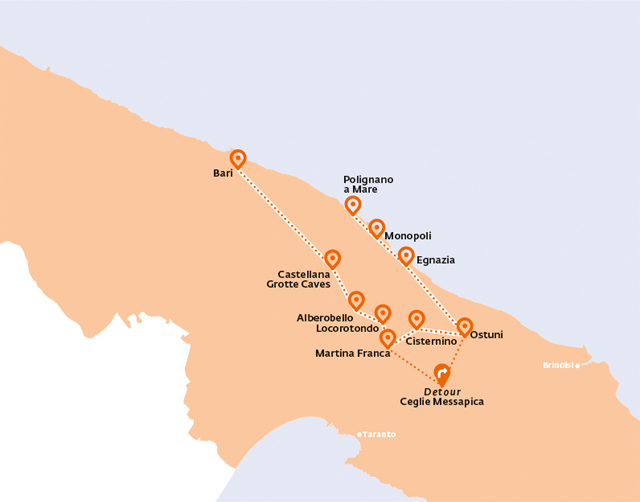
Start with a blast of urban grit in Bari. Puglia’s regional capital is a city of colourful markets, busy boulevards and grand municipal buildings. Much of the city’s new town dates to the 19th century but it’s in Bari Vecchia, the tangled historic centre, that you’ll find the city’s main drawcards, including the Basilica of San Nicola, Norman-Swabian castle and the Cathedral of San Sabino.

As you head southeast from Bari, take time to stop off at the Castellana Grotte Caves on the northwestern edge of the Itria Valley. As you descend into the vast cave complex, you enter a strange, haunting underworld of weird rock formations and dripping stalactites and stalagmites. The highlight is the eerily beautiful Grotta Bianca (White Grotto). From the caves, it’s a further 17 km to UNESCO-listed Alberobello, Puglia’s trulli capital, which counts more than 1400 of these surreal and fairy-tale houses. Many are packed into the Rione Monti district, to the southwest of central Piazza del Popolo. For the best views search out the Belvedere Santa Lucia. The vista is amazing but it’s one you’re unlikely to enjoy on your own. The town is largely given over to tourism and it can get very busy between May and October. Much better to come in the quieter, off-peak months.
A unique feature of the Itria Valley are the UNESCO-listed conical-capped white houses known as trulli (singular, trullo). These drystone constructions, made with roughly worked limestone boulders, first appeared in the 14th century and quickly sprouted across the area. Their odd, Hobbit-like design might look simple but it’s ideally suited to the local climate with their thick walls ensuring they stay cool in summer. It’s also said that the lack of mortar meant they could be dismantled quickly, thus enabling their owners to avoid paying taxes on them.


Hilltop Locorotondo is a memorable sight as it appears like a white boat bobbing on a sea of green. There are few must-see’s as such but its circular historic centre is a joy to explore with its gleaming white houses and colourful displays of balcony flowers. You can admire great views of the surrounding valley from the Villa Comunale and you’ll want to dedicate some time to tasting the town’s celebrated white wine.
The main town in the Itria Valley, Martina Franca boasts exquisite baroque architecture and an elegant historic centre. On Piazza Roma, the 17th-century Ducal Palace is a showcase example of the local baroque style with a grandiose facade and lavish rococo interior. In summer, it’s used to stage events and exhibitions during the Festival della Valle d’Itria. From the piazza, Via Vittorio Emanuele, known locally as u’ring, leads to Piazza Plebiscito overlooked by the 18th-century Basilica of San Martino.

With its charming, casbah-like core, Cisternino is recognised as one of the Borghi più Belli d’Italia (Italy’s Most Beautiful Towns). As you wander its tangled streets look out for the Torre Civica, dating to the Norman-Swabian period (11th to 12th centuries) and, on its left, the town’s Chiesa Madre. Cisternino’s real drawcard, however, are its fornelli (butchers’ shops doubling as basic eateries) where you can dine on delicious grilled meat. Once you’ve had your fill, push on to Ostuni.
This chic white town marks the end of the Itria Valley and the beginning of the hot, dry Salento. Most people come in summer to lap up the festive atmosphere and hang out in its busy bars and restaurants. Holidays apart, it has a couple of worthy sights: a dramatic 15th-century cathedral, and a museum, the Museo di Civiltà Preclassiche della Murgia Meridionale, showcasing finds from a nearby Paleolithic burial ground, including the skeleton of a 25,000-year-old woman.

Some 12 km southwest of Ostuni, Ceglie Messapica merits a quick detour. An ancient agricultural settlement dating to Greek and Messapian times, it initially looks like a typical rural town with its labyrinthine white centre and the usual collection of piazzas, palazzos and churches. However, Ceglie is renowned regionally as a foodie hotspot and it has a number of excellent eateries, including its very own Michelin-starred restaurant. Its culinary calendar culminates in August when prestigious chefs and hungry crowds flock to town for its annual food festival.
About 34 km northwest of Ostuni, the Archaeological Park of Egnazia is one of Puglia’s most important ancient sites. It safeguards the seafront ruins of Gnathia, once a prosperous Messapian and Roman city. Few intact buildings remain but you can see parts of the original Roman road, Via Traiana, and admire artefacts, including Messapian tombs and painted ceramic vases, in the small museum. From the site, it’s a simple 20-minute drive up the coast to Monopoli.
This laid-back port will win you over with its vivid colours, pretty historic centre and glorious aquamarine waters. Life in the centre revolves around Piazza Garibaldi, from where it’s a short walk to the 16th-century castle and Santa Maria seafront. In and around town there are plenty of fine swimming spots including Porto Ghiacciolo, known for its cooler waters, and Capitolo, a trendy and much frequented spot.
Celebrated as the birthplace of crooner Domenico Modugno, Polignano is dramatically set atop a rocky outcrop, riddled with marine grottoes and scenic coves. The town’s most famous inlet is the Lama Monachile, whose surrounding cliffs provide the venue for the Italian leg of the Red Bull Cliff Diving World Series. For a more artistic spectacle, search out the Fondazione Museo Pino Pascali, where modern art is displayed in the town’s former abattoir.


BuyPuglia is the digital system tailored to suit your tourism business in Puglia. Our matching platform is an easy tool to explore meeting opportunities with Puglian suppliers and learn about their tourism &.. cultural products. BuyPuglia ranks buyers and sellers based on entered information. Shared interests are paired, helping plan effective meetings and delivering optimized supply &.. demand solutions.